

Ao Nang Beach in Krabi, Thailand, has evolved from a once-quiet fishing village to one of the most popular tourist destinations in Thailand. Its history of tourism dates back to the 1980s when backpackers and intrepid travelers began to discover the crystalline waters, stunning limestone cliffs, and laid-back vibe of the area.
In the 1980s and early 1990s, Ao Nang was just a small collection of modest accommodations catering to those seeking a more secluded and authentic Thai beach experience. The main draws were the incredible natural beauty, the friendly local community, and the opportunities for rock climbing and exploration. In fact, Krabi, and particularly the area around Ao Nang, is renowned for its rock climbing opportunities, which drew in a niche group of adventure tourists.
As word spread about the area's beauty, more visitors began to arrive, prompting the development of a range of tourist facilities, including hotels, resorts, restaurants, and tour operators. The 1990s saw a significant growth in tourism, positioning Ao Nang as a convenient base for exploring the region, with quick access to famous islands like Koh Phi Phi and Railay Beach.
In the 2000s, Ao Nang's tourism industry boomed, transforming it into a bustling tourist hub. The introduction of international chain hotels and luxury resorts offered tourists from around the globe a wide spectrum of accommodations. The area also expanded its recreational activities, including diving, snorkeling, and eco-tours, catering to the diverse interests of visitors.
The devastating tsunami of 2004 had a significant impact on tourism in the area. Despite the challenges, the resilient spirit of the local community and support from international aid facilitated a swift rebuilding process. This period also saw renewed efforts to preserve and showcase the natural beauty of Ao Nang while building a sustainable tourism industry.
In the 2010s, Ao Nang witnessed a trend towards more sustainable and community-based tourism, with visitors showing an increased interest in authentic experiences and cultural immersion. Tourists seek out eco-friendly tours, cooking classes, and local homestays to engage more deeply with the community.
The global COVID-19 pandemic has hit the tourism sector hard, and Ao Nang was not spared. However, the area has been adapting by implementing health and safety measures to reassure and welcome back tourists. As travel restrictions ease, there is a growing interest in "slow travel" and wellness retreats, reflecting a shift in tourist priorities post-pandemic.
Today, Ao Nang Beach continues to be a vibrant destination offering a blend of Thai charm and international amenities. Whether visitors seek relaxation on the beach, adventure in the nearby jungles and cliffs, or gastronomic delights, Ao Nang caters to a variety of tourists and promises a memorable Thai beach experience.
The local community and authorities are now focused on sustaining and balancing the growth of tourism with environmental conservation, ensuring that Ao Nang remains a beautiful gem in Thailand’s tourism crown for generations to come.